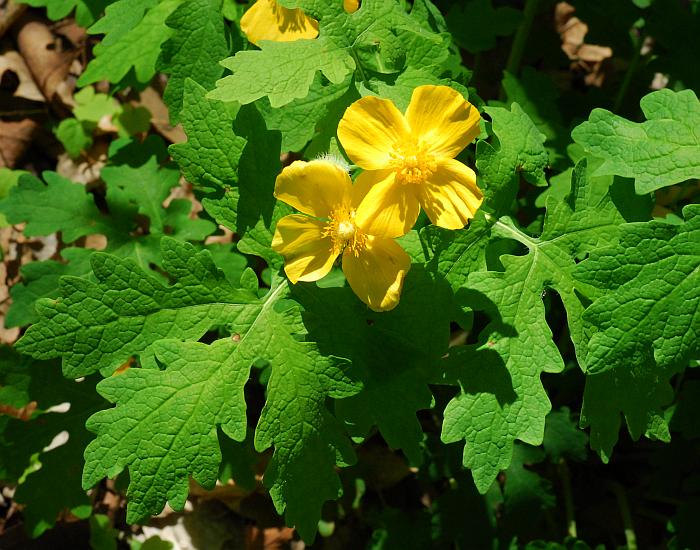Stylophorum diphyllum (Michx.) Nutt.
Celandine Poppy

Native
CC = 7
CW = 5
MOC = 18
© SRTurner
Stylophorum diphyllum (Michx.) Nutt.Celandine Poppy | |
 |
Native CC = 7 CW = 5 MOC = 18 |
© SRTurner |
|
Family - Papaveraceae Habit - Perennial forb from a woody caudex, with thick, sometimes branched rhizomes. Sap yellow to yellowish orange. Stems - Loosely to strongly ascending, to 50 cm, sometimes branched, often purplish-tinged at the base, moderately to densely pubescent with fine, more or less spreading, multicellular hairs, often glaucous.
Leaves - Leaves with the upper surface green, glabrous, the undersurface pale and glaucous, sparsely hairy. Basal leaves several, 30-50 cm long, long-petiolate, the petiole to 16 cm, pilose, and often purplish-tinged at the base, with a shallow adaxial groove, the blades pinnately deeply lobed or compound into 5 or 7 lobes or leaflets, these oblong-obovate, rounded at the tip, the margins irregularly scalloped and/ or bluntly toothed, sometimes also shallowly few-lobed. Stem leaves 2, subopposite, similar to the basal leaves, but somewhat smaller and usually short-petiolate.
Inflorescences - Terminal umbel, sessile, few-flowered, sometimes reduced to a solitary flower, the individual flower stalks 2-5 cm long, ascending, glaucous, hairy, slightly expanded at the tip but not forming a cup or disc, each with a bract at the base, this 3-5 mm long, narrowly oblong-elliptic, hairy along the entire margins and usually also sparsely so on the undersurface.
Flowers - Sepals 2, free, shed individually as the flower opens, 12-15 mm long, broadly elliptic-ovate and deeply concave (cupped around the flower), broadly pointed at the tip. Petals 4, 20-30 mm long and wide, broadly obovate, rounded at the tip, yellow, glabrous. Stamens numerous, from below the pistil. Filaments yellow, to 7 mm long, glabrous. Anthers yellow, 2 mm long, 1 mm broad, compressed. Ovary superior, 6-10 mm long in flower, 3-4 mm in diameter, narrowly ovoid, tapered to a persistent style 3-6 mm long, the stigma more or less capitate, with 3 or 4, shallow, spreading lobes. Placentation parietal.
Fruits - Pendent capsules 20-30 mm long, nodding, ellipsoid, moderately to densely pubescent with relatively stout, bristly, multicellular hairs, dehiscing longitudinally from the tip by 4 valves. Seeds 1.6-2.1 mm long, ovoid, with a crestlike aril along 1 side, the surface otherwise with a network of fine ridges and pits, light brown to brown, not shiny.
Flowering - April - June. Habitat - Bottomland and mesic forests, streambanks, and bases and ledges of bluffs, ravine bottoms. Origin - Native to the U.S. Lookalikes - Chelidonium majus. Other info. - This strikingly showy plant can be found in Missouri mostly in southeastern and east-central counties. Outside of Missouri its main distribution is within a few northeastern states of the U.S. Midwest. It is relatively easy to identify from its paired leaves, brilliant yellow flowers, and bristly fruits. It can appear similar to Chelidonium majus (greater celandine), but that species has smaller flowers and fruits, and sepals and fruits which are glabrous. Photographs taken in the Ozark Scenic Riverways, Shannon County, MO., 5-12-03, and in Columbia, MO., 4-15-04 (DETenaglia); also at Engelmann Woods Natural Area, Franklin County, MO, 4-6-2010, 4-18-2014, and 5-9-2014, Shaw Nature Reserve, Franklin County, MO, 5-21-2015, and Salt Lick Point, near Valmeyer, Monroe County, IL, 4-30-2018 (SRTurner). |